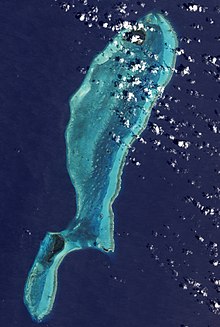Great Blue Hole
| Great Blue Hole | |
|---|---|
 The Great Blue Hole | |
| Location | Lighthouse Reef, Belize |
| Coordinates | 17°18′55″N 87°32′4″W / 17.31528°N 87.53444°W |
| Depth | 124 m (407 ft) |


The Great Blue Hole is a large marine sinkhole off the coast of Belize. It lies near the center of Lighthouse Reef, a small atoll 70 km (43 mi) from the mainland and Belize City. The hole is circular in shape, 318 m (1,043 ft) across and 124 m (407 ft) deep.[1][2] It has a surface area of 70,650 square metres (760,500 sq ft). It was formed during several phases of the Quaternary glaciation when sea levels were much lower. Analysis of stalactites found in the Great Blue Hole shows that formation took place 153,000, 66,000, 60,000, and 15,000 years ago. As the ocean began to rise again, the cave was flooded.[3] The Great Blue Hole is a part of the larger Belize Barrier Reef Reserve System, a UNESCO World Heritage Site.[4]
Exploration
[edit]The site was made famous by Jacques Cousteau, who declared it one of the top five scuba diving sites in the world. In 1971 he brought his ship, the Calypso, to the hole to chart its depths.[5] Investigations by this expedition confirmed the hole's origin as typical karst limestone formations, formed before rises in sea level in at least four stages, leaving ledges at depths of 21 m (69 ft), 49 m (161 ft), and 91 m (299 ft). Stalactites were retrieved from submerged caves, confirming their previous formation above sea level. Some of these stalactites were also off-vertical by 5˚[1] in a consistent orientation, indicating that there had also been some past geological shift and tilting of the underlying plateau, followed by a long period in the current plane. The tilt indicates that this was movement of the land, rather than a rise in sea level alone.[5] The initial measured depth of the Great Blue Hole was about 125 m (410 ft) which is the most often cited depth up to this day.
An expedition was conducted in the summer of 1997 to collect core samples from the Blue Hole's floor and document the cave system.[6] To accomplish these tasks, all of the divers had to be certified in cave diving and mixed gases.[6]
In December 2018, two submarines descended into the Blue Hole in an attempt to map its interior. Using sonar scanning, the team was nearly able to complete a 3-D map of the 1,000-foot-wide (300 m) hole. One of their discoveries was a layer of hydrogen sulfide at a depth of approximately 300 feet (91 m). The water at that depth and below becomes dark, anoxic and devoid of life.[7] The submarine expedition also discovered the bodies of two divers at the bottom, out of three believed to have gone missing while diving there, and reported them to Belizean authorities. Out of respect, the crew declined to bring the bodies back to land, thus leaving them buried at sea.[8]
Tourism
[edit]The Great Blue Hole is a popular destination for recreational scuba divers making day trips from the coastal tourist communities in Belize.[citation needed]
On-shore caves of similar formation, as large collapsed sinkholes, are well known in Belize and in the Yucatán Peninsula, where they are known as cenotes. Unlike the mainland cenotes which often link to underwater cave systems, there is little evidence of horizontal development in the Blue Hole.[citation needed][clarification needed]
In 2012, Discovery Channel ranked the Great Blue Hole as number one on its list of "The 10 Most Amazing Places on Earth".[9][dead link] In 2018, they featured a two-hour special titled Discovery Live: Into the Blue Hole featuring Erika Bergman, Fabien Cousteau and Richard Branson.[10]
See also
[edit]References
[edit]- ^ a b The Great Blue Hole of Lighthouse Reef Atoll, Belize, Central America: Deep Technical Diving to Collect Sea-Level Records. Transactions of the Fifteenth Caribbean Geological Conference. 2002. ISBN 9789766401009.
- ^ "Expedition Survey of Belize's Great Blue Hole with Ellipse INS sensor". Geo-matching. Retrieved 21 September 2023..
- ^ "Belize Blue Hole reef". NASA. 3 April 2009.
- ^ UNESCO World Heritage Foundation. "Belize Barrier Reef Reserve System". Retrieved 11 January 2023.
- ^ a b Jacques-Yves Cousteau (1973). Galapagos – Titicaca – The Blue Holes (Hole). London: Cassell.
- ^ a b Tysall, Terrance N (1999). "The Belize Blue Hole Exploration Project". In Hamilton, RW; Pence, DF; Kesling, DE (eds.). Assessment and Feasibility of Technical Diving Operations for Scientific Exploration. American Academy of Underwater Sciences. Archived from the original on 16 April 2013. Retrieved 8 January 2011.
{{cite book}}: CS1 maint: unfit URL (link) - ^ Street, Francesca (15 February 2019). "Dispatches from the bottom of Belize's Blue Hole". CNN. Retrieved 16 May 2021.
- ^ Carlos, Naia (5 April 2019). "Bodies Of Missing Divers Found At The Bottom Of Belize Great Blue Hole". Tech Times. Retrieved 18 August 2021.
- ^ Robert Lamb; Amanda Arnold (2012). "The 10 Most Amazing Places on Earth". Discovery Channel. Archived from the original on 9 November 2012. Retrieved 12 September 2013.
- ^ "DISCOVERY LIVE: INTO THE BLUE HOLE". Retrieved 3 December 2018.
External links
[edit]- Official website of the Great Blue Hole

